Are you a Quiet Speculation member?
If not, now is a perfect time to join up! Our powerful tools, breaking-news analysis, and exclusive Discord channel will make sure you stay up to date and ahead of the curve.
Sorry, Team #MaritLage and Eldrazi haters. Innistrad's got a new "guardian," and Lady Sprankle's going to have a tougher job pulling off the prerelease cosplay this time.
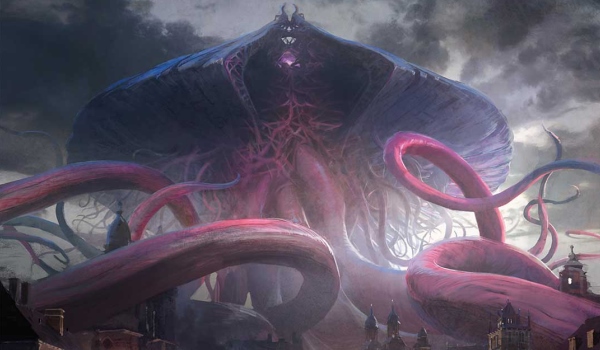
Eldritch Moon previews get their formal kickoff next Monday, but Emrakul had to make her promised appearance early just in case the suspense was still killing you. Of all the legendary creatures in Modern, old Emrakul, the Aeons Torn has long been one of the most iconic, terrifying, and commanding presences on the battlefield. That sets a high bar for Emrakul 2.0, although if there's one thing we've learned in the past few months it's to never underestimate the Eldrazi. As card evaluation launches in earnest across the Modern community, we'll be doing an in-depth analysis of Emrakul's potential in post-Eldritch Moon Modern. Today, we're mixing theoretical assessment with test results to give you the fullest picture of the Eldrazi's chances in a format that is historically inhospitable to new cards. Thankfully for anyone preordering these at the $20-$25 mark, Emrakul's second coming has all the hallmarks of an excellent Modern contributor, and as the article will show, I have high hopes for her future.
[wp_ad_camp_1]
The End is Nigh!
I don't always center card images. But when I do, I prefer big, epic, splashy mythics. Trevor prefers Damnation. Whatever your preference, I'm honoring Wizards' poster-horror with a centerfold spotlight. Stay tentacled, my friends.

Iä! Iä! Cthulhu Emrakul fhtagn! Or, as Kimberly Kreines' characters heralded in her Monday story, "I'amrakul, Me'mrakul, Come'mrakul, Be'mrakul!" Some called the whole reveal cheesy, but I'm a man who owns most of the Arkham Horror expansions, so I'm giddy about the Lovecraft throwbacks.
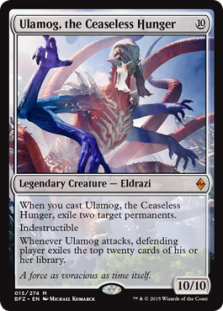 Between Emrakul on Monday morning, Ulrich and Coax later in the day, and a suitably horrifying end for the weird town of Hanweir on Tuesday, we're off to a delightful Eldritch Moon start. I'm giving the set's flavor an A+ so far, especially with Hanweir's fate in full view. Now it's just a question of set playability. As we've talked about before on the Nexus, card evaluation can be very challenging when it comes to new sets, whether for content producers or the average player. Sometimes we get it right: see my appraisal of Ulamog, the Ceaseless Hunger back during Battle for Zendikar's release. Sometimes we don't: see Lumbering Falls in that same Battle article.
Between Emrakul on Monday morning, Ulrich and Coax later in the day, and a suitably horrifying end for the weird town of Hanweir on Tuesday, we're off to a delightful Eldritch Moon start. I'm giving the set's flavor an A+ so far, especially with Hanweir's fate in full view. Now it's just a question of set playability. As we've talked about before on the Nexus, card evaluation can be very challenging when it comes to new sets, whether for content producers or the average player. Sometimes we get it right: see my appraisal of Ulamog, the Ceaseless Hunger back during Battle for Zendikar's release. Sometimes we don't: see Lumbering Falls in that same Battle article.
With Emrakul 2.0 kicking off Moon previews, it's fitting the legendary Eldrazi also kicks off our new card evaluation. Following from the Shadows Over Innistrad card evaluation guidelines we discussed in February, it's impossible to look at new Emrakul and not see Urza's Tower and friends towering in the background. Or, more appropriately, the foreground, lovingly wrapped in tentacles.
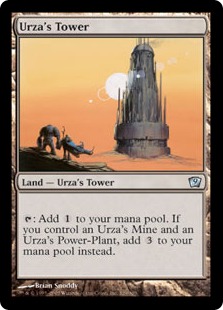 RG Tron is a consistent Tier 1 Modern player, and has been taking top slots from late 2015 through present. Although UW Tron, Mono-Blue Tron, and even Eldrazi Tron could also claim the Promised End, Modern seldom sees new cards push old archetypes into the top tiers. Existing top-tier decks, however, are perfect proving grounds for the newest technology. This is even true of decks with relatively established cores---after gaining Ulamog in the fall, many initially skeptical RG Tron players ultimately dumped their expensive Emrakul, the Aeons Torn in favor of the reliable turn 4-5 threat. Eye of Ugin's banning cemented Ulamog's status as Tron's curvetopper of choice, but with new Emrakul on the horizon, Ulamog might have competition.
RG Tron is a consistent Tier 1 Modern player, and has been taking top slots from late 2015 through present. Although UW Tron, Mono-Blue Tron, and even Eldrazi Tron could also claim the Promised End, Modern seldom sees new cards push old archetypes into the top tiers. Existing top-tier decks, however, are perfect proving grounds for the newest technology. This is even true of decks with relatively established cores---after gaining Ulamog in the fall, many initially skeptical RG Tron players ultimately dumped their expensive Emrakul, the Aeons Torn in favor of the reliable turn 4-5 threat. Eye of Ugin's banning cemented Ulamog's status as Tron's curvetopper of choice, but with new Emrakul on the horizon, Ulamog might have competition.
Of course, it's possible another deck leverages Emrakul more effectively than mainstay RG Tron. I'm a huge fan of both blue Tron variants, and Emrakul's cost-reduction is significantly better in a deck packing more card types and discard outlets like Thirst for Knowledge. Similarly, we could see a Tronless Eldrazi variant ride Emrakul up to Tier 2 or higher. These scenarios are fun thought experiments for brewers but not very likely in the grand metagame scheme of Modern. In the vast majority of cases, a deck already needs to be tiered before a new card pushes it higher. The sub-Tier 3 fringe doesn't count---sorry, Eggs loyalists. If you have other Emrakul brews you're working on, take them to the comments and we'll chat there. For now, I'm sticking with old RG Tron faithful as Emrakul's best chance for post-Eldritch Moon success.
Dissecting Emrakul, the Promised End
Card evaluation is typically conducted in a vacuum. There, players assess a card based on gut instinct and theory alone, which is an economic approach that typically produces the correct answer: "Modern-unplayable." Unfortunately, when it misses it can miss in a big way, as it did with most people (myself included) who didn't quite realize how busted Thought-Knot Seer and pals were with Eye and Eldrazi Temple. This underscores the need to augment theory with other data sources.
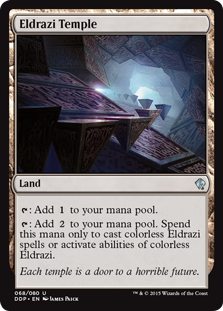 If you're lucky, evaluators include some context with their evaluations: a decklist, a matchup, a metagame perspective, etc. If you're very lucky, you get a handful of tests to actually back up the theoretical claims. And if you've got Norin the Wary fortune, you'll get more extensive testing across a few matchups. That's how you stumble on the Colorless Eldrazis of the format. You don't discover format-defining tech by posting one-liner put-downs on Reddit.
If you're lucky, evaluators include some context with their evaluations: a decklist, a matchup, a metagame perspective, etc. If you're very lucky, you get a handful of tests to actually back up the theoretical claims. And if you've got Norin the Wary fortune, you'll get more extensive testing across a few matchups. That's how you stumble on the Colorless Eldrazis of the format. You don't discover format-defining tech by posting one-liner put-downs on Reddit.
That said, this approach to evaluation is not perfect. Lists are unrefined, matchups often don't account for a metagame's reaction to new technology, and sample sizes tend to be small. Pitfalls aside, it's an invaluable approach to making a more accurate assessment of a card, even if it isn't necessary infallible.
I'm adopting a similar approach in my Emrakul analysis. I piloted a modified Joe Lossett Grand Prix Los Angeles list (-2 Ulamog, +2 Emrakul) in a mini-gauntlet against Mike Sigrist's Jund, Lan Ho's Infect, and Erik Carson's Abzan Company, all Top 8 or Top 16 lists from the recent Grand Prix. A friend and I played only four matches each with most going to three games, for a total match sample of n = 12 and a total game sample of n = 29. Of those tests, Emrakul apeared in 14 of them, which is our "final" test n. Resist the urge to leap down to the comments about a small n: I'm only using the tests to triangulate the theoretical and metagame evaluations, which lets us get away with less testing. Besides, as I've said in previous data analysis articles, most Moderners make evaluations off n = 1 or n = 0 datasets all the time. Combining the 14 Emrakul test games with all the usual new card theorizing positions us to be much more accurate about Emrakul's chances than if we stayed in theoryland alone.
With those methods in mind, I'm going to parse all of Emrakul's card text, citing relevant examples and numbers from the n = 14 tests to bolster the analyses. I'll also compare Emrakul's abilities to their Ulamog, the Ceaseless Hunger equivalents in each category. Remember: all of these analyses are situated in the RG Tron backdrop, not the context of another deck. Sure, Mono-Blue Tron might get Emrakul down to nine or even eight mana, but Mono-Blue Tron isn't even cracking Tier 3 right now. We always want to focus our evaluation efforts on the highest-tier home, not the optimistic fringe.
Casting cost 13 (minus cost reduction)
At 13 alone, Emrakul would likely be too expensive even for RG Tron. Sans disruption, Tron can typically generate about eight mana on turn four, 9-10 mana on turn five, and 11-12 mana on turn six. At least, that was my average across the 29 games played. You'll see Tron up to 10 mana on turn four via double Urza's Tower, but it's not common and still puts you on track for 11-12 mana on the subsequent turns barring absurd draws. Ulamog matches this curve nicely, especially with the rare double Tower line on turn four, and 13-cost Emrakul would have been hitting 1-3 turns later.
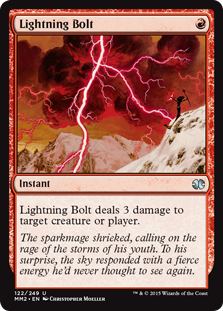 Thankfully for Eldritch Moon's villain, Emrakul comes with a cost reduction mechanic I've heard described as "delirium affinity." That's an accurate, flavorful, and helpful way of thinking about her mechanic, and it fits well with the Tron plan. You're virtually guaranteed to have at least an artifact and a sorcery in your graveyard by the time you could cast Emrakul anyway, even with Relic of Progenitus anti-synergy. This means she's really an 11-drop, not 13. In Lossett's build, Lightning Bolt gets her down to 10---notably, you can even Bolt and Emrakul in the same turn and it will cost 11 mana either way. Just don't cast Emrakul first!
Thankfully for Eldritch Moon's villain, Emrakul comes with a cost reduction mechanic I've heard described as "delirium affinity." That's an accurate, flavorful, and helpful way of thinking about her mechanic, and it fits well with the Tron plan. You're virtually guaranteed to have at least an artifact and a sorcery in your graveyard by the time you could cast Emrakul anyway, even with Relic of Progenitus anti-synergy. This means she's really an 11-drop, not 13. In Lossett's build, Lightning Bolt gets her down to 10---notably, you can even Bolt and Emrakul in the same turn and it will cost 11 mana either way. Just don't cast Emrakul first!
Over the course of my 14 Emrakul games, I averaged a turn six Eldrazi with nothing earlier than turn five. In all those scenarios, I also calculated when I could have cast Ulamog instead if I had been running the Ceaseless Hunger in the Promised End's slots. There was one game where Ulamog could have dropped on turn four instead of Emrakul's turn five, but in all the rest, he averaged the exact same as Emrakul: a turn six casting. This also matches our theoretical experience of Tron, where you may need to spend turns 3-5 stabilizing with a Wurmcoil, Karn, Pyroclasm, Stone, or other option. That sets up Ulamog or Emrakul for your turn six haymaker.
Ulamog vs. Emrakul Verdict: Tie
Ulamog's casting cost is slightly cheaper, but this rarely plays out in actual games. In practice, they land on the same turn.
13/13 and keyworded stats
Emrakul represents 13 mana for a 13/13. Ulamog represents 10 mana for a 10/10. Needless to say, poor Griselbrand is jealous of such elegant design, and 13/13 is flat better than 10/10. Decks like Jund can easily put themselves at 13 life or less with Dark Confidant, Thoughtseize, shocks, and fetches, which makes Emrakul's 13 power a potential knockout. I don't want to jump ahead too much, but adding flying and trample to the package make it even better. With no evasion or pseudo-evasion keywords, Ulamog gets chumped by Birds of Paradise all day long. Emrakul tramples over and often wins in two hits. Sometimes even a single swing does the job, which happened in a pair of Jund games following particularly painful Mindslaved turns with some self-Bolting and Kolaghan's Commanding.
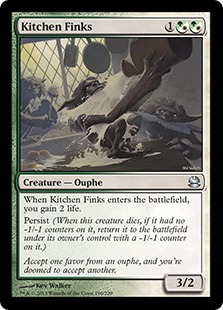 Despite lacking keyworded evasion, Ulamog does have a critical pseudo-evasion in his library exiling trigger. Even when chumped, Ulamog wins most games in three swings, and may even prompt a concession before if a critical combo piece or bullet gets exiled as part of the 20-card feast. This is particularly relevant against Abzan Company players, who may have reached stratospheric life totals off an earlier Kitchen Finks combo only to be devoured by Ulamog triggers later. You'll also see the exiles wreck decks like Scapeshift and Ad Nauseam which rely on specific cards remaining in their libraries. In the face of lifegain (e.g. Affinity's Vault Skirge, Kitchen Finks, or chump blockers soaking up damage), Emrakul might not win on that third swing. Ulamog always gets it done.
Despite lacking keyworded evasion, Ulamog does have a critical pseudo-evasion in his library exiling trigger. Even when chumped, Ulamog wins most games in three swings, and may even prompt a concession before if a critical combo piece or bullet gets exiled as part of the 20-card feast. This is particularly relevant against Abzan Company players, who may have reached stratospheric life totals off an earlier Kitchen Finks combo only to be devoured by Ulamog triggers later. You'll also see the exiles wreck decks like Scapeshift and Ad Nauseam which rely on specific cards remaining in their libraries. In the face of lifegain (e.g. Affinity's Vault Skirge, Kitchen Finks, or chump blockers soaking up damage), Emrakul might not win on that third swing. Ulamog always gets it done.
Ulamog vs. Emrakul Verdict: Ulamog wins!
Ulamog's inevitability and random disruption give him a slight edge over Emrakul's higher power. Clocks matter in Modern, but with both cards averaging a turn six casting, the extra turn often matters less on a relatively stable board. Also, against decks that run out of steam where you want to close fast (e.g. Suicide Zoo), unblocked 10/10 Ulamog tends to win in as short an order as unblocked 13/13 Emrakul.
Flying and trample
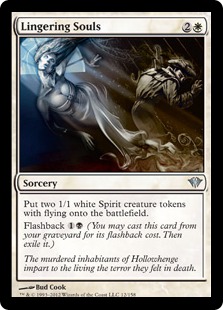 Here's one that's all Emrakul, all the time. Ulamog doesn't even have corresponding keywords to call his own, and flying plus trample are a dangerous package. Old Emrakul always had the problem of getting blocked by a spare Birds of Paradise or Thopter token, nuking much of the board but not actually affecting life-totals. The Promised End retains Emrakul 1.0's flying but adds trample, which is great for busting through flocks of obnoxious Lingering Souls tokens and other aerial obstacles. This is a categorical edge over Ulamog, who rarely wins in a damage race for lack of trample or flying (let alone both).
Here's one that's all Emrakul, all the time. Ulamog doesn't even have corresponding keywords to call his own, and flying plus trample are a dangerous package. Old Emrakul always had the problem of getting blocked by a spare Birds of Paradise or Thopter token, nuking much of the board but not actually affecting life-totals. The Promised End retains Emrakul 1.0's flying but adds trample, which is great for busting through flocks of obnoxious Lingering Souls tokens and other aerial obstacles. This is a categorical edge over Ulamog, who rarely wins in a damage race for lack of trample or flying (let alone both).
As Affinity and Infect players can attest, flying is also critical on the defensive. Inkmoth Nexus, Vault Skirge, Signal Pest, and even a Plated or modulared Ornithopter can easily race a landlocked Ulamog by shredding you from the sky. Emrakul can actually block these cards, giving Tron extra points in a close matchup (Affinity) and in one of its absolute worst (Infect). Sure, Ulamog can exile these fliers on-cast, but sometimes the opponent topdecks a threat that kills you a turn out. Or sometimes it's Affinity and they have more threats than you can answer in a double Vindicate.
Ulamog vs. Emrakul Verdict: Emrakul wins!
Ulamog's all vanilla in this category, so Emrakul takes it by default.
Protection from instants
Let's get this out of the way up front: "protection from instants" is mostly a strict downgrade from "protection from colored spells." I guess new Emrakul lost some of her power traversing the blind eternities. Or, more plausibly, R&D is trying to create a flavorful subgame around Emrakul stealing your turn, expending your sorcery spell removal, and then freeing you as you race to find an answer. Whatever the reason, protection from instants is what we get, and it compares directly to Ulamog's indestructible keyword.
Here's a comparison that's 100% metagame context. If we were playing a Standard environment packed with sorcery-speed hard removal, Emrakul would look a lot sillier for her instant protection. Fortunately, this is Modern, so we need to assess the Eldrazi titans in the context of our format's removal spells. Looking at top-tier decks, we can quickly separate removal into four categories:
- Removal that hits both Eldrazi: e.g. Liliana of the Veil, Karn Liberated, Nahiri, the Harbinger, Fiend Hunter.
- Removal that hits neither Eldrazi: e.g. Terminate, Lightning Bolt, Abrupt Decay.
- Removal that hits only Ulamog: e.g. Path to Exile, double Dismember
- Removal that hits only Emrakul: e.g. Maelstrom Pulse, Supreme Verdict, Dreadbore, combat damage.
We're ignoring removal in the first two categories, as well as all the fringe nonsense which might fit there. I'm looking at you, Detention Sphere and other corner-case oddballs people are going to try and use to argue for one card or the other. If removal hits both or hits neither, it's not worth considering. That brings us to the final two categories, which are obviously much more important. They are also obviously weighted heavily in favor of Emrakul.
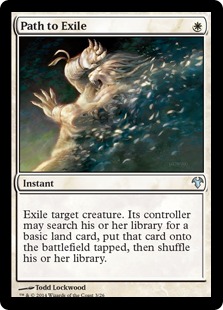 After Lightning Bolt, Path is the most-played removal spell in Modern and it's not even close. Indeed, Path is even more prevalent today with Jeskai Control back in Tier 1 and Kiki Chord just behind in Tier 2. Both strategies tend to pack the full playset. By contrast, you're seeing Jund players on a 1/1 or 2/0 split between Pulse and Dreadbore, and Wrath of God effects relegated to the sideboard. That's a serious knock against Ulamog, who gets a taste of his own exiling medicine down the barrel of a Path.
After Lightning Bolt, Path is the most-played removal spell in Modern and it's not even close. Indeed, Path is even more prevalent today with Jeskai Control back in Tier 1 and Kiki Chord just behind in Tier 2. Both strategies tend to pack the full playset. By contrast, you're seeing Jund players on a 1/1 or 2/0 split between Pulse and Dreadbore, and Wrath of God effects relegated to the sideboard. That's a serious knock against Ulamog, who gets a taste of his own exiling medicine down the barrel of a Path.
Emrakul, however, is Path-proof. Thinking contextually, Path is also a much scarier spell than Pulse or Dreadbore because Path decks typically rebuy their Paths with Snapcaster Mage or Eternal Witness. That's an uphill battle for Ulamog and it's one Emrakul dodges altogether. As a final note on this, Emrakul didn't die to either card once in any of the Jund tests, despite facing down a Pulse in two games. Turns out the Mindslaver effect is just as good in practice as it is on paper at clearing the way.
Ulamog vs. Emrakul Verdict: Emrakul wins!
Emrakul may be vulnerable to more spells, but Ulamog dies to the more common spell.
On-cast Mindslaver
In one corner, we have the on-cast Mindslaver of Emrakul. In the other corner, we have the double exiling Vindicate of Ulamog. May the best Eldrazi trigger win!
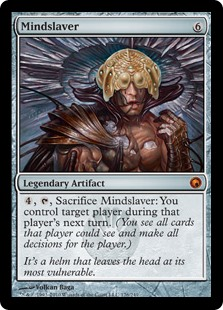 I've read a lot of back-of-the-napkin Emrakul analysis since her Monday release, and the mini-Mindslaving ability is by far the most misevaluated element of the card. I believe this arises from players analyzing in a vacuum and not thinking about the expected value of both triggers in real games. That is, how much removal-value can we expect to get when we cast Ulamog vs. when we cast Emrakul? For Ulamog, that's an easy one: we'll always exile two permanents, whether a bomb like Nahiri and a Restoration Angel, or just a pair of lands to take an opponent off a color. For Emrakul, it's significantly harder to translate a Mindslaver activation into removal-value without any context. It's even harder when it's not a true Mindslaver and gives the opponent a post-madness turn to recover and find answers. That's where testing helps in a big way.
I've read a lot of back-of-the-napkin Emrakul analysis since her Monday release, and the mini-Mindslaving ability is by far the most misevaluated element of the card. I believe this arises from players analyzing in a vacuum and not thinking about the expected value of both triggers in real games. That is, how much removal-value can we expect to get when we cast Ulamog vs. when we cast Emrakul? For Ulamog, that's an easy one: we'll always exile two permanents, whether a bomb like Nahiri and a Restoration Angel, or just a pair of lands to take an opponent off a color. For Emrakul, it's significantly harder to translate a Mindslaver activation into removal-value without any context. It's even harder when it's not a true Mindslaver and gives the opponent a post-madness turn to recover and find answers. That's where testing helps in a big way.
Of all the different abilities tested today, this was the one which was most present in the 14 gauntlet games. Every time I cast Emrakul, I also assessed the board to see how Ulamog's exile effect would have swung the game. I compared Ulamog's double-exile to Emrakul's Mindslaving impact, tallying both the number of cards "removed" and the effect on the board. Here were the results of that expected value (EV) tracking, averaging numbers across the games:
- Ulamog EV: 2 permaments (averaging 1 land, 1 creature)
- Emrakul EV: 3.5 cards (1.7 from the hand, 1.7 from play averaging 0.4 lands and 1.3 creatures)
Ulamog always hit two permanents, and I really do mean "always." Even on the most win-more boardstates, Ulamog is still going to eat two lands and be sated. Heck, sometimes killing two lands is actually the correct play even facing down a swarm of creatures. By contrast, Emrakul was averaging 3.5 cards removed, split 50/50 between cards from the hand and cards from the board. Cards from the hand include Bolts aimed at an opponent's own head, self-Thoughtseize, Chord of Calling to fetch Viscera Seer (brutal), pump spells fired at irrelevant creatures, etc. Cards from the board included suicidal creatures charging into Emrakul, targets of an opponent's own removal, permanents sacrificed to Seer or a topdecked Arcbound Ravager (again, brutal), etc.
Digging a little deeper, here's the distribution of Emrakul EVs across the 14 games:
- Emrakul hits 1 card: 1
- Emrakul hits 2 cards: 1
- Emrakul hits 3 cards: 5
- Emrakul hit 4 cards: 4
- Emrakul hits 5 cards: 2
- Emrakul hits 6 cards: 1
Compared to Ulamog, Emrakul only underperformed the double-exile once and matched Ulamog once again. In all other cases, she outperformed the Battle titan with almost half of her triggers doubling (or more) Ulamog's two-card value. If these numbers look fun on paper, it's because they absolutely are fun on the gaming table. In one of the more representative examples, Emrakul onto an Infect board saved me from the impending Blighted Agent attack, allowing me to activate Inkmoth, swing with the Nexus into Emrakul, and then fire off two pump spells on the Agent (exiling the graveyard with Become Immense). An infected 12/12 Emrakul was a small price to pay for my opponent sinking into topdeck mode with only three lands and a lone Agent.
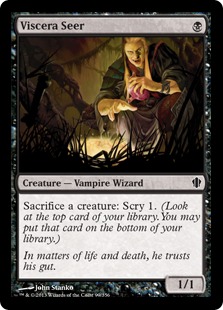 Emrakul gets really crazy when you add things like Spellskite, Arcound Ravager, Viscera Seer, Kolaghan's Command, Snapcaster Mage, and other cards that allow for devastating two-for-ones or worse. In one line against Abzan Company, my opponent drew Chord on their enslaved turn. I played the two Hierarchs in their hand, convoked everything for Seer, and then sacrificed their entire board of five creatures to scry a Temple Garden to the top of their deck. In another, I attacked Tarmogoyf into Emrakul, -2'd a Liliana to kill the opponent's lone Confidant, and then Kolaghan's Commanded the two-loyalty Lily while also using Command to discard a Pulse. As I said earlier: brutal.
Emrakul gets really crazy when you add things like Spellskite, Arcound Ravager, Viscera Seer, Kolaghan's Command, Snapcaster Mage, and other cards that allow for devastating two-for-ones or worse. In one line against Abzan Company, my opponent drew Chord on their enslaved turn. I played the two Hierarchs in their hand, convoked everything for Seer, and then sacrificed their entire board of five creatures to scry a Temple Garden to the top of their deck. In another, I attacked Tarmogoyf into Emrakul, -2'd a Liliana to kill the opponent's lone Confidant, and then Kolaghan's Commanded the two-loyalty Lily while also using Command to discard a Pulse. As I said earlier: brutal.
Of course, these represent ideal scenarios. Emrakul appears to hit three cards most of the time, typically a creature and two spells or a spell and two creatures. It's also worth noting that Emrakul can rarely hit active lands the same way Ulamog can, so unless those are manlands you can throw into suicidal charges, the mana will stick around for the recovery turn. Then again, speaking of recovery turns, my opponent only won one of their 14 games in which Emrakul resolved. It turns out the extra post-Mindslaved turn doesn't matter much when you're down 3+ cards. By contrast, reversing the game-state and replaying as if Ulamog had been drawn rather than Emrakul, my opponent was able to eke out the win against Ulamog in three of the 14 games. This is probably close enough to suggest no real difference and just underscore the point that both cards will generally seal the game in equal measure, although Emrakul gets the slight advantange in an admittedly small n.
Ulamog vs. Emrakul Verdict: Emrakul wins!
The expected value of an Emrakul trigger is higher and generally more impactful than that of an Ulamog trigger. Its floor is a bit lower, but its ceiling is significantly higher and you are more often on the higher end than the lower.
The verdict: playable
Given all these factors, Emrakul is looking mighty playable as an Ulamog complement or outright replacement in future metagames. Much of this is contingent upon comparing their on-cast triggers, which is why I dedicated so much of this article to that section. Of course, given testing limitations, it's possible I've misevaluated the expected value of Emrakul's removal, which would in turn misevaluate the card as a whole. Speaking with experienced Tron pilots, I also note the importance of not making unqualified one-to-one comparisons between Ulamog's double permanent removal and Emrakul's removing cards more generally. Locking midrange decks off mana can be very valuable (that's often as true in aggressive matchups too), and there are certainly boardstates where a creature-clogged battlefield needs hard removal, not a hope that opponents have removal spells in hand to pitch on their own creatures.
These cautions aside, I'm still very optimistic about Emrakul's early indicators, and I'll keep testing them as Eldritch Moon unfolds. Ad Nauseam is treating me well on MTGO, but I'm hearing the Tron call and might be making some Karn Liberated purchases soon.
Howling at the Eldritch Moon
Don't expect this kind of deep-dive analysis for all the upcoming Eldritch Moon goodies, although I'll try to get some testing done before reporting back on any notable cards. I'm holding out hope for some playable Werewolves, even if Ulrich is more novelty puppy than pack alpha, and am also optimistic we'll see some zany and (please, dear R&D Gods) less broken Eldrazi. I'm also still holding out hope for that Innocent Blood reprint we've been waiting for since 2011. I don't want to jinx it, but you can bet what card will get a centered image or two (or four...) if it makes the final Moon cut.
Thanks for joining me and Emrakul today on our joint testing sessions. I'm certainly a believer, and that's not just the delirium talking. Do you have any experience with new Emrakul so far? Where else are you planning on testing the new Eldrazi and how do you expect them to fare? I'll be keeping a close eye on Eldritch Moon spoilers as the week goes on, so tune in to the Twitter feed in case anything Modern-worthy comes through the rumor pipeline. See you all soon and remember to Test'mrakul your cards for evaluating them!





I want Promised End as a singleton in some kind of (probably Mardu) Nahiri/FLooting shell. You could tutor her with Nahiri’s ultimate (and then have a reasonable chance of re-casting, due to having been able to loot lots of card types), or even loot her into your graveyard alongside Unburial Rites for a turn four reanimation.
Agree. That’s also something you might see in Jeskai, where you can easily see 4-5 card types in the yard in the late-game. I’d still bet on her in Tron before anything else, but Mardu or Jeskai could work too.
Quick one: “and then Kolaghan’s Commanded the two-loyalty Lily”
You cannot redirect damage from your own spells to Planeswalkers you control.
306.7. If noncombat damage would be dealt to a player by a source controlled by an opponent, that opponent may have that source deal that damage to a planeswalker the first player controls instead. This is a redirection effect (see rule 614.9) and is subject to the normal rules for ordering replacement effects (see rule 616). The opponent chooses whether to redirect the damage as the redirection effect is applied.
Good to know! I expect more people will become familiar with this rule in the future. It wouldn’t have affected the board state too much either way. Knowing this, I would have blocked and killed the Confidant (not the Goyf), +2’d the Lily to discard Command, and then Pulsed her with the open mana. I’m still very comfortable with that four-card swing.
712.3. Only control of the player changes. All objects are controlled by their normal controllers. A player who’s being controlled during his or her turn is still the active player.
Also an incredibly relevant rule. Some might try to argue that you (emmy player) are controlling the Kommand. You are not.
Good addition for players to know. Can’t wait until we get a judge call on camera for this sort of thing.
So one cannot bolt his/her own planeswalkers?
Nope, and that’s a rule I didn’t know until now but one I expect all of Modern will learn after EMN is released.
First off, great methodology! Comparing the cast triggers in real games (and playing them out twice) seems like a great way to use data driven analysis.
The problem that I have is gauntlet selection, Tron already wrecks Abzan CoCo and Jund and it isnt even close (baring them warping their SBs and even then …). I would have much rather seen you play against historically bad matchups like burn, scapeshift, or affinity (in addition to infect).
It was a fun method! I can think of some ways to improve it in the future (for instance, players making different decisions knowing about Ulamog vs. Emrakul triggers), but I liked where it started.
With regard to the matchups, even if Emrakul is improving Ulamog’s rate in the GOOD matchups, that’s still a great datapoint. For instance, if Jund was 60/40 with Ulamog and 65/35 with Emrakul (without costing too many percentage points elsewhere), that’s a fine swap on the spot. It’s important to make sure Emrakul isn’t making good matchups worse, and that was the point of doing that particular mini-gauntlet. I’d expect those EV rates to basically hold steady in other matchups.
I have to admit that my expectations regarding Emrakul’s performance were very low coming in, especially regarding casting it in a timely fashion, but your data looks quite convincing (and definitive, all sample-size caveats taken into consideration). I think this really makes an argument for a 1 Emrakul/1 Ulamog split going forward, which allows you to have your cake and eat it too. That also avoids the unlikely-but-possible scenario where you have both Ulamogs in your hand. I still think it also has potential in U-Tron, but the question is what finisher it replaces. That question is complicated by the fact that most U-Tron finishers are fetchable, whereas Emrakul wouldn’t be (other than the Eldrazi Wish card, which I guess could be a thing U-Tron could use). Thoughts?
I was also a bit skeptical about Emrakul when I first saw her, but the EV numbers were just very convincing. Can’t wait to see her in action more! As for Mono Blue Tron, I like the idea of bringing in 1-2 Coaxes into the main and rolling with Emrakul as a possible win condition. The Blue Tron graveyard is bigger than RG Tron’s, and the deck has TfK to add even more fuel. All of this could point to a more viable Blue Tron deck after EMN hits shelves.
After reading your article i really wanted to try it out. Being an old U-tron player, the mindslaver effect looked appealing but my initial thought on the card was not soft…
I decided to try it out in a Through the breach/valakut shell and so far, both time i was able to cast her, it game me the game. here’s my list if anyone want to test it :
4x primeval titan
4x sakura tribe elder
1x Oldrakul
1x Newrakul
2x oracle of mul daya
4x through the breach
4x search for tomorrow
4x oath of nissa
3x lightning bolt
2x farseek
2x summoner’s pact
1x summoning trap (not sure if i use a 3rd summoner’s pact)
2x nahiri, the harbinger
1x anger of the gods
6x mountain
4x stomping ground
4x valakut
4x wooded foothills
3x forest
2x cinderglade
2x arid mesa
1x sacred foundry
I’m opened to suggestions to help make the deck better. With oath and the nahiri, i can drop Emmy’s cost to 7 at max and it isn’t rare that i have 8-9 mana on the field in the mid/late -game
Forgive me if I’m not understanding, but I think there is an error in the EV for newrakul here. Since the mindslaver effect also gives the opponent an extra turn, does that not net the opponent an extra card from the extra draw step? I didn’t see that mentioned in the EV anywhere (although maybe I’m missing it), but that should reduce the EV of newrakul by 1 in all situations, making the comparison a bit closer.
I’m happy to see that new Emmy doesn’t totally suck. I was hoping it was good since my first modern deck almost 2 years ago was Mono U Tron. My favorite turn-control story actually came from standard with Worst Fears against a UB Control. It turns out that stacking 3 Pearl Lake Ancient triggers into discarding 3 board wipes and a win condition is really good!
I’m a bit annoyed about the rules change with checking sideboards (it was my favorite lesser-known trick). Oh well, wizards does what wizards wants.